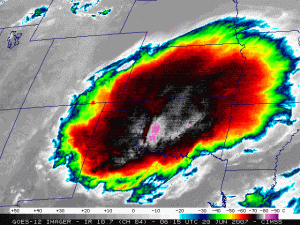Ordinary thunderstorms are a few miles in diameter and exist for less than an hour. The life cycle of an ordinary thunderstorm contains three stages: cumulus, mature and dissipating.

The cumulus stage is the initial stage of a thunderstorm as warm moist air near the ground rises. The mature stage of an ordinary thunderstorm begins when precipitation starts to fall from the cloud. During the mature stage, the thunderstorm produces the most lightning, rain, and can produce even small hail. The dissipating stage of a thunderstorm occurs when the updraft, which provides the required moisture for cloud development, begins to weaken and collapse. During this stage, the downdraft dominates the updraft and the storm begins to disappear.
Groups of these ordinary single-cell thunderstorms often join into larger systems and are generically referred to as mesoscale convective systems, or MCSs. A mesoscale convective complex, or MCC, is an example of a MCS. It is a complex of individual thunderstorms that covers a large area, about 40,000 square miles, in an infrared satellite image, roughly the size of the entire state of Iowa. In satellite images, MCCs appear as a cluster of thunderstorms that give the appearance of a large circular storm.
MCCs are longer lived than ordinary thunderstorms and last for more than six hours. MCCs often begin forming in the late afternoon and evening and reach mature stages during the night and toward dawn. A MCC is a multicell storm composed of convective cells in different stages of their life cycles. For MCCs to exist, the individual thunderstorms of the system must support the formation of other convective cells. The downdrafts of individual cells of the MCC form and enhance the updrafts of neighboring cells.
Steve Ackerman and Jonathan Martin, professors in the UW-Madison department of atmospheric and oceanic sciences, are guests on WHA radio (970 AM) at noon the last Monday of each month. Send them your questions at stevea@ssec.wisc.edu or jemarti1@wisc.edu.

